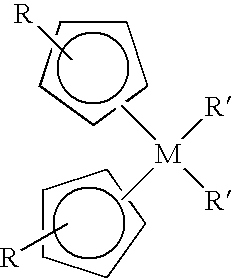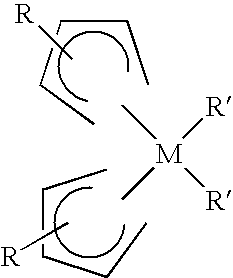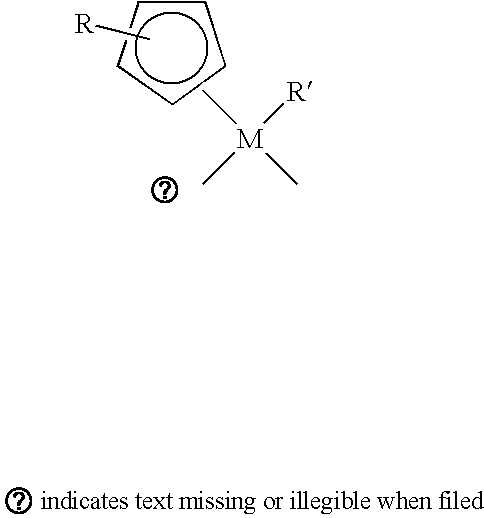Method of forming high-k dielectric films based on novel titanium, zirconium, and hafnium precursors and their use for semiconductor manufacturing
a technology of zirconium and hafnium, which is applied in the direction of metal/alloy conductors, organic chemistry, and conductors, etc., can solve the problems of affecting the final properties of the surface/interface, affecting the final properties of the product, and other possible byproducts, depending on the oxygen source used, to achieve the effect of not enabling self-limited deposition in the ald process
- Summary
- Abstract
- Description
- Claims
- Application Information
AI Technical Summary
Benefits of technology
Problems solved by technology
Method used
Image
Examples
example i
Deposition of Metal Oxide Film M1O2 with M1 being Preferably Hafnium and Zirconium
[0083]The film to be deposited relates to the case where a=0, b is about 2 and c=0.
[0084]To make the deposition of such film on the surface of a wafer or in a deep trench to manufacture MIM structures for DRAM, one need to vaporize the M1 metal source as defined in steps (b) and / or (h) here above into the reactor (preferably Hafnium or Zirconium), inject an oxygen source, preferably moisture, oxygen or ozone into said reactor, react the products at appropriate temperature (preferably between 150° C. and 350° C.) and pressure (preferably between 25 Pa and 1000 Pa) for the duration necessary to achieve either a thin film deposition on the substrate or to fill out deep trenches by ALD or pulse CVD process (sequential pulse injection of metal sources are necessary in order to allow regular deposition of the oxide in the trench to progressively fill out this trench and provide no voids in the dielectric fil...
example ii
Deposition of Metal Oxynitride Films M1ON with M1 being Preferably Hafnium and Zirconium
[0116]The film deposited relates to the case where a=0 and b and c are different from zero.
[0117]All the information given in Example I is applicable in this Example II, except that nitrogen needs to be introduced into the reactor.
[0118]The nitrogen shall be selected from a nitrogen source selected from the group comprising nitrogen (N2), ammonia, hydrazine and alkyl derivatives, N-containing radicals (for instance N., NH., NH2.), NO, N2O, NO2 or the like.
example iii
Deposition of M1M2 Metal Oxide Films with M1 being Preferably Hf or Zr and M2 being Preferably Si or Al
[0119]The film deposited on the substrate in this example illustrates the case wherein a≠0, b≠0 and c=0.
[0120]All the information given in Example I are applicable in this Example III, except that a M2 metal source is additionally needed.
[0121]The M2 containing precursor is also introduced into the reactor to crate the M2 source of metal. This M2 containing precursor source shall be preferably:
a) a silicon (or germanium) source and is selected from, but not limited to, the group consisting of disiloxane, trisilylamine, disilane, trisilane, a alkoxysilane SiHx(OR1)4-x, a silanol Si(OH)x(OR1)4-x (preferably Si(OH)(OR1)3; more preferably Si(OH)(OtBu)3 an aminosilane SiHx(NR1R2)4-x (where x is comprised between 0 and 4; R1 and R2 are independently H or a C1-C6 carbon chain, either linear, branched or cyclic; preferably TriDMAS SiH(NMe2)3; BTBAS SiH2(NHtBu)2) BDEAS SiH2(NEt2)2) and mixt...
PUM
| Property | Measurement | Unit |
|---|---|---|
| temperature | aaaaa | aaaaa |
| temperature | aaaaa | aaaaa |
| temperature | aaaaa | aaaaa |
Abstract
Description
Claims
Application Information
 Login to View More
Login to View More - R&D
- Intellectual Property
- Life Sciences
- Materials
- Tech Scout
- Unparalleled Data Quality
- Higher Quality Content
- 60% Fewer Hallucinations
Browse by: Latest US Patents, China's latest patents, Technical Efficacy Thesaurus, Application Domain, Technology Topic, Popular Technical Reports.
© 2025 PatSnap. All rights reserved.Legal|Privacy policy|Modern Slavery Act Transparency Statement|Sitemap|About US| Contact US: help@patsnap.com



